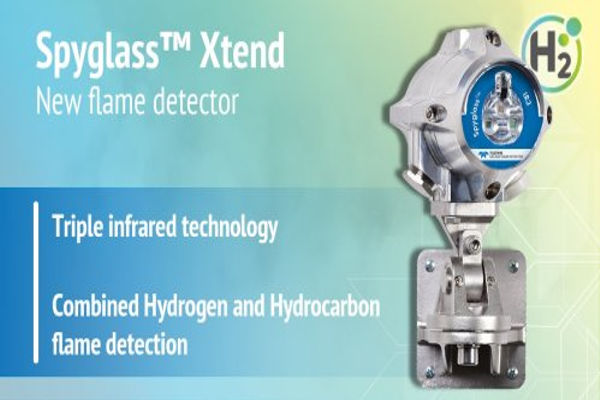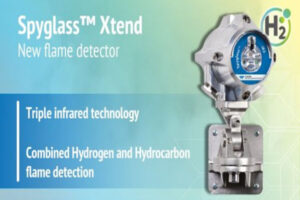A significant advancement in the industry, the Spyglass Xtend triple-infrared flame detector from Teledyne Gas & Flame Detection (Teledyne GFD) allows for the simultaneous detection of both hydrogen (H2) and hydrocarbon (HC) fires.
In dense industrial settings, where hydrogen flames can spread to adjacent equipment and ignite fires involving hydrocarbon fuels that are invisible to an H2-only detector, this significant advance improves safety.
With the triple-infrared technology developed by Teledyne Gas and Flame Detection, it is now possible to detect both hydrogen and hydrocarbon fires simultaneously. A hydrogen flame can spread and start a fire involving hydrocarbon fuels in industrial areas that are heavily populated with machinery, tools, equipment, stored goods, and many other common working things. Spyglass Xtend can offer a vital safety net in this situation.
Consider the scenario where a hydrogen flame is detected by an H2-only detector, which then triggers a safety measure to cut off the hydrogen supply and put out the flame. The emergency may seem to be gone, but any hydrocarbon fires that are already burning will continue to burn. HC flames are not detectable by an H2 detector.
The new Spyglass Xtend flame detector enables an expanded safety approach by simultaneously detecting hydrogen and hydrocarbon flames thanks to its integrated triple-infrared technology and special algorithm. There are five different sensitivity levels to choose from.
Reliable operation in outdoor settings is ensured by the new triple-infrared technology, which offers complete immunity against false alarms or premature defects caused by sun glare or severe rain.
Heated optics further facilitate outdoor use by preventing freezing and condensation, and users can verify nominal detector function by performing manual or automated self-tests to ensure the lenses are clean. The stainless steel enclosure is rated for both NEMA 4X/6 and IP66/68 ingress protection.
Numerous universal current outputs, such as analogue 4-20 mA, sink or source, alert, and fault, are available with Teledyne Gas and Flame Detection’s Spyglass Xtend. Additionally, an optional HART® 7 digital output facilitates simple configuration and diagnostic capabilities for preventive maintenance plans. The new flame detector is certified by ATEX, IECEX, usFMc, and Safety Integrity Level (SIL 2).
With its simultaneous, quick, and accurate detection of both hydrogen and hydrocarbon flames, the new Spyglass Xtend is a strong contender for any dense industrial setting seeking to improve safety credentials and provide more protection for workers and assets. There are two variants: one with and one without on-board HD video output. The HD video option provides automated video recording during alerts and real-time area monitoring for comprehensive post-event analysis.
Leadership Comments 
“Users of our Spyglas Xtend can take advantage of a considerably longer detection range, while response times are much faster compared with existing UV/IR technology,” explains Régis PRÉVOST, Product Line Manager at Teledyne GFD. “The result? Earlier detection of hydrogen and/or hydrocarbon flames, protecting workers and minimising damage to your premises and assets. It’s also worth pointing out that the hydrogen flame detection performance of the Spyglass™ Xtend matches that of our existing Spyglass™ IR3-H2, which is dedicated solely to hydrogen.”
For Further Info, CLICK HERE




